Red Sea Diving Resort: The holiday village run by spies
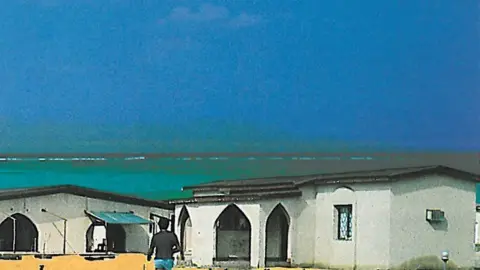 BBC
BBCArous was an idyllic holiday resort in the Sudanese desert, on the shores of the Red Sea. But this glamorous destination was also a base for Israeli agents with a secret mission. The events inspired a newly released Netflix film, Red Sea Diving Resort - and the real story is in many ways more remarkable.
"Arous on the Red Sea, a wonderful world apart," the glossy brochure says, pronouncing it "the diving and desert recreation centre of Sudan".
Illustrated with pictures of putty-coloured chalets on a sun-drenched beach, a smiling couple in scuba gear, and varieties of exotic fish, the advertisement boasts of "some of the best, clearest water in the world". As night falls - "after the landscape colours have paled" - there are, it says, "breathtaking views of the heavens, aflame with millions of stars".
Arous Village, on the fringe of spectacular coral reefs and the odd shipwreck, appears to be a diving enthusiast's dream.
The pamphlets were printed in their thousands and distributed in specialist travel agents across Europe. Reservations were booked through offices in Geneva and Khartoum. And over time hundreds of guests went on holiday there.
It was a long trek. But once at the desert oasis, they enjoyed first-rate facilities, water sports, deep-sea dives and an abundance of fresh food and wine. The visitors' book was a catalogue of glowing comments.

The Sudanese International Tourist Corporation was also happy. It had leased the site to a group of people introducing themselves as European entrepreneurs, whose venture brought some of the first foreign tourists to the country.
The only thing was, unbeknown to the guests or the authorities, the Red Sea diving resort was entirely fake.
It was a front, set up and run for more than four years in the early 1980s by operatives from the Mossad, Israel's intelligence agency.

More Long Reads:

They used it as a cover for an extraordinary humanitarian mission - to smuggle out thousands of beleaguered Ethiopian Jews stranded in refugee camps in Sudan and evacuate them to Israel. Sudan was an enemy country tied to the Arab world, and it had to be done without anyone finding out, either there or at home.
The operation was so secret, only the people directly involved knew. The agents did not even tell their own families.
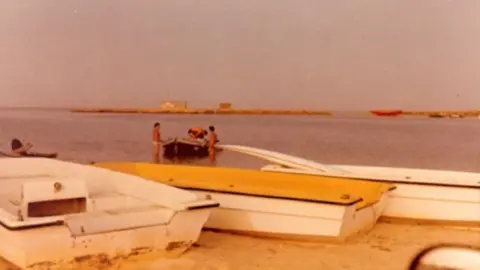 Raffi Berg
Raffi BergThe Ethiopian Jews belonged to a community called Beta Israel (House of Israel), whose origins are shrouded in mystery.
For many centuries, a prominent theory contended they were descended from Israelites who had accompanied a son of the Queen of Sheba and King Solomon back to Ethiopia around 950BC, smuggling the Ark of the Covenant with him. It has alternatively been suggested they ended up there after fleeing civil war in ancient Israel, or fled into exile after the destruction of the Jewish Temple in Jerusalem 586BC.
By the early 1970s, Israel's chief rabbis officially endorsed the views of illustrious rabbis down the ages that the Beta Israel belonged to one of the so-called 10 lost tribes, who disappeared from history following an invasion of the Kingdom of Israel in the 8th Century BC.
The Ethiopian Jews adhered to the Torah, practised a Biblical version of Judaism, and prayed in buildings similar to synagogues. But, isolated from the rest of Jewry for millennia, they believed they were the last remaining Jews in the world.
In 1977 one of their members, Ferede Aklum, wanted by the Ethiopian authorities for "anti-government activity" (Aklum was suspected of sympathising with rebels and of treachery for encouraging Jews to emigrate to Israel) escaped to Sudan, along with a wave of non-Jewish Ethiopian refugees fleeing civil war and a deepening food crisis.
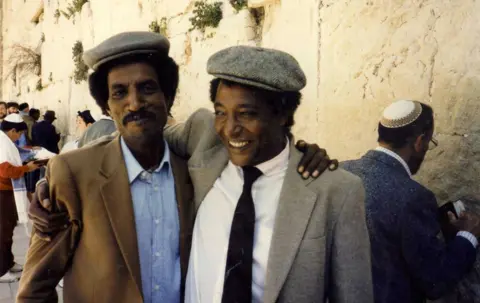 AAEJ Archives Online
AAEJ Archives OnlineHe sent letters to relief agencies, pleading for help to get to Israel, and one found its way to the Mossad. For the then Israeli Prime Minister, Menachem Begin - himself a refugee from Nazi-occupied Europe - Israel existed as a safe haven for Jews in peril. The Beta Israel were no exception and he ordered the intelligence agency to act.
The Mossad instructed one of its operatives, Dani, to locate Ferede and find a way of smuggling any Ethiopian Jews in Sudan out and on to Israel.
After a difficult search - "like finding a needle in a haystack", says Dani - the agent tracked Ferede down in Khartoum and the two men teamed up. Ferede channelled messages back to his community in Ethiopia, saying the way to Jerusalem lay through Sudan, and they should follow his lead.
It offered the tantalising opportunity of fulfilling a 2,700-year-old dream. In the period up to late 1985, some 14,000 Beta Israelis took the chance and made the perilous 800km (500-mile) journey by foot.
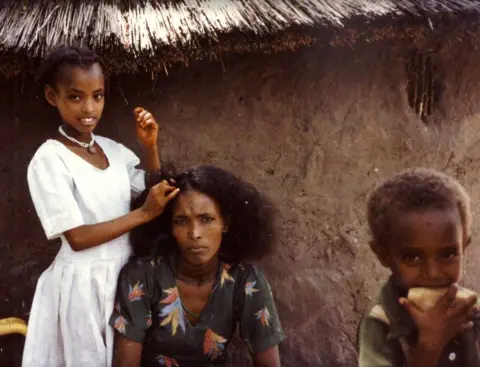 AAEJ Archives Online
AAEJ Archives OnlineAbout 1,500 of the Jewish refugees were killed along the way, perished in the squalid camps around Gedaref and Kassala, or were abducted.
As there were no known Jews in Sudan, a Muslim-majority country, they hid their religion so as to blend in and not get caught by the Sudanese secret police. Despite the risk, they continued their Jewish practices, such as snuffing out fires in the camps before Sabbath (when Jewish law forbids lighting flames) and eating only meat which complied with Jewish dietary rules.

Rescue mission
Almost straight away, some small-scale clandestine evacuations got under way, led by Dani and Ferede, with Ethiopian Jews smuggled through Khartoum airport to Europe on forged papers, then on to Israel. But as numbers grew, it became clear that another way was needed.
"I was thinking about the sea," recalls Dani in my forthcoming book on the operation. "Sudan was not like Ethiopia [where civil war and mountainous terrain meant Jews there could not be transported over land to the coast]. If we could evacuate people [from Sudan] by the Red Sea and have a boat coming in, then we could do things on a larger scale."
It was on a trip up Sudan's coast looking for possible landing beaches in late 1980 that Dani and another agent stumbled across an abandoned resort at Arous, about 70km (43 miles) north of Port Sudan.
"We saw something that looked to us like a mirage," he says. "We saw buildings with red tiled roofs - [but] we were in Sudan, we were not somewhere else."
A caretaker informed them that it had been run by an Italian company but had shut a couple of years earlier. He let them inside and showed them around.
"We understood immediately the meaning of this," Dani says. "If we get this village we are kings of the land - with a thing like that [as a cover], the sky's the limit!"


What happened next was the subject of the Netflix film Red Sea Diving Resort. Shot in Namibia - where they recreated the resort - and South Africa, the film depicts the operation and the holiday village. It stars Captain America actor Chris Evans, whose character in the Netflix film is based on Dani (the two met when Evans was researching the role). Other lead characters are based on members of the Mossad team recruited by Dani for the mission.
The film makes clear it is "inspired" (rather than based on) real events, leaving ample room for invention. Some scenes loosely represent what happened, but some parts are pure Hollywood (for instance, no Jews were ever smuggled through the resort itself, and the Americans did not know about the operation, let alone airlift the refugees out - something which was done by the Israeli air force).
Completed in 1974 by Italian entrepreneurs, the resort was a cluster of 15 red-roofed bungalows, a kitchen and a large dining room opening out to the beach, a lagoon and the sea.
There was no infrastructure in place (not even an approach road) but the Italians brought in a generator and got fresh water from Port Sudan. They ran it quite successfully for five years but after disputes with Sudanese officials they pulled out, and the resort shut a year later.
"It's a very difficult place to run, if you don't have the Mossad behind you," says an agent involved in the operation who did not wish to be identified.
Posing as the director of a Swiss-based tourism company (which did not in actual fact exist), Dani convinced the Sudanese authorities that he could revive the resort and bring in tourists again. They agreed to let him rent it for $250,000 (approx £106,000 at the time).

Fake resort
Dani and members of his team spent the first year renovating it. The resort was kitted out with Israeli-made equipment, including air-conditioning units, outboard motors, and top-of-the-range water sports gear - including the first windsurfing board in Sudan - all smuggled into the country.
They also recruited about 15 local staff, including chambermaids, waiters, a driver and a chef "poached" from a hotel. "We paid him double," said the unnamed operative. None of the staff knew the resort's real purpose, or that their Caucasian managers were Mossad agents.
Female members of the team were put in charge of the day-to day running of the place, which it was thought would lower any suspicions.
The diving storeroom was out-of-bounds. In it were concealed radios the agents used to keep in regular contact with headquarters back in Tel Aviv.
While seeing to their guests by day, every so often at night a squad would leave under cover of darkness and head to a rendezvous point 900km (560 miles) away on the edge of Gedaref.
There they would pick up groups of Ethiopian Jews, smuggled out of the camps by so-called Committee Men - a handful of Beta Israel recruited for the job.
"At first, the refugees were given 24 hours' notice that they were going to be taken to taken out - they were not told where to but understood it was Jerusalem - but eventually we could not give them any notice at all because of the risk it would leak out," says Dani. "They were just quietly woken up and told it was time to leave."
From there, a convoy of lorries carrying dozens of bewildered refugees drove a two-day journey, travelling only by night and hiding in a concealed wadi during the day.
In the early days of the operation, the vehicles would run through checkpoints, but this practice stopped when a guard opened fire (though he missed).
When the Jews disembarked at the wadi, they sometimes kissed the ground in the mistaken belief that they had already reached the holy city.
Once they got to the coast near the holiday village, Israeli navy special forces would come ashore on Zodiac dinghies, collect the refugees and transport them to an Israeli ship, the INS Bat Galim, waiting further out at sea.
The ship then took them to Israel.
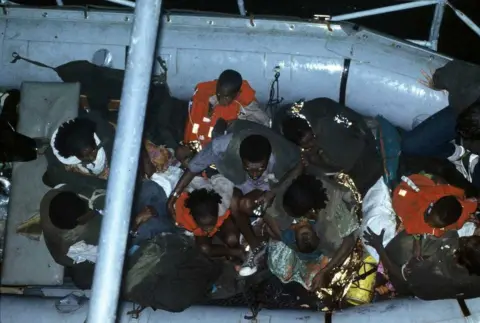
"It was constantly dangerous," says the unnamed operative. "We all knew that if any one of us got exposed, we'd end up hanged on gallows in the centre of Khartoum."
They came close to it in March 1982, when on the third such operation the group was spotted in mid-transfer on the beach by Sudanese soldiers. Possibly suspecting smugglers, a soldier opened fire - but the Zodiacs, with the Ethiopians on board, managed to get away.

After that, it was decided naval evacuations were too exposed, and a new plan was devised. The agents were tasked with finding a suitable landing spot in the desert for C130 Hercules planes. The refugees were going to be secretly airlifted out of the country.

Read more about Ethiopian Jews:

In the meantime, the Israelis continued to run the diving resort and entertain the guests. By now, Arous Village had earned quite a reputation and word spread.
"Arous was really beautiful," one former American guest told me. "They had these lovely little vacation cabins and you'd go out on boats and go diving or snorkelling. The underwater scenery was just breathtaking.
"I remember the 'European' staff all looked young and really healthy and fit, and at dinner time, people would say: 'Why the heck [build a resort] here?' Of course, the answer was it was totally gorgeous and unspoilt, and people were saying: 'Wow, I hope they can make a go of it.'"
The resort counted among its varied clientele an Egyptian army unit, a group of British SAS soldiers, foreign diplomats from Khartoum and Sudanese officials - all unaware of their hosts' true identity.
Arous Village made enough money to sustain itself financially, much to the relief of the accountants back at Mossad HQ. Some of the takings were used to buy or rent the lorries that took the refugees.
Airlifted to safety
Meanwhile, the airlifts got under way. Israeli air force planners identified an abandoned World War Two British airfield not far from the coast, and in May 1982 the first Hercules, carrying Israeli commandos, landed there in the dead of night.
"Many of the Ethiopian Jews had never even seen a lorry before, so to them the commandos waving green stick lights looked like aliens, and they were afraid to go inside [the plane]," recalls Dani.
 Getty Images
Getty ImagesAfter two airlifts however, the Mossad discovered Sudanese authorities had got wind of suspicious activity and were planning an ambush. The team was then instructed to find more inconspicuous landing sites.
They identified suitable locations much nearer Gedaref, which had the advantage of reducing the time on the road with the refugees to a couple of hours. The downside was "they weren't airstrips, they were just a piece of desert", according to the unnamed agent.
"The strips were hardly lit," he says. "We had just 10 tiny infrared lights and the C130 pilots had to find us without navigational aids and after a long, tedious flight, in pitch black.
"By comparison, Entebbe was a piece of cake as far as flying's concerned," he says, referring to the daring hostage rescue in Uganda in 1976, which saw an Israeli Hercules land at the airport in a surprise raid and fly out again with more than 100 people freed by commandos.
Despite the complexities and potentially catastrophic consequences of failure, 17 clandestine flights were carried out, co-ordinated by the agents of the Red Sea diving resort.
Towards the end of 1984, famine was declared in Sudan, and it was decided to further escalate the evacuations.
With intervention from the US, and a large payment, Sudan's president, Gen Jaafar Nimeiri, agreed to let Jewish refugees be flown directly out from Khartoum to Europe. He did so on condition of total secrecy, so as to avoid repercussions from the rest of the Arab world.
In a series of 28 covert airlifts, on a Boeing aircraft lent by a Jewish Belgian airline owner, 6,380 Ethiopian Jews were flown to Brussels and then straight on to Israel. The airlift was codenamed Operation Moses.
 Getty Images
Getty ImagesThere was a media blackout in Israel, but eventually the news was leaked.
The story gets out
Newspapers around the world ran the story on 5 January 1985 and Sudan immediately stopped the flights. It publicly denied any involvement, dismissing allegations it had colluded with Israel as a "Zionist-Ethiopian plot".
Two months later, following a direct request by then US Vice-President George Bush, a further, final secret airlift from Sudan was allowed by Nimeiri to take out the 492 Ethiopian Jews stranded by the abrupt halt of Operation Moses. Although Nimeiri insisted that they be flown to Europe, the planes took them straight to Israel.
The Mossad continued running the holiday village, keeping it available as an undercover option. Despite a pause in operations, the agents still had to cater for the influx of guests, and even flew in more operatives at Easter time to help at the resort when it was full.
Outside, the atmosphere was changing. Street protests against Nimeiri which had begun in March escalated, and on 6 April 1985, the president was overthrown by army officers. It was a turn of events that imperilled the operatives at the village.
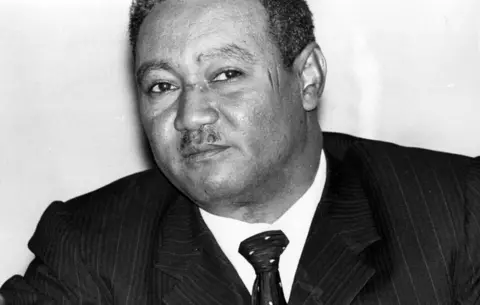 Getty Images
Getty ImagesThe new military junta turned its sights on flushing out Mossad spies, real or imaginary, to burnish its credentials in the Arab world.
The head of the Mossad gave the order to evacuate the resort. Banking on it being safer to wait until the end of the busy Easter week, the team stayed put. Then, at an opportune moment, they told staff they were leaving for a couple of days to look for new diving spots.
"Six of us left the diving village in two vehicles before dawn," says another of the agents, who also requested anonymity. "A C130 landed to the north, on a landing spot we had never used before. We got on it and came home.
"There were tourists in the village," he says. "They would have woken up and found themselves alone in the desert. The local staff were still there, but no-one else - the diving instructor, the lady manager and so on, all the Caucasians had disappeared."
When the plane landed at an air-force base outside Tel Aviv, they drove out in the same Sudanese vehicles they had boarded with.
In the wake of the agents' sudden departure, the diving village shut down.
 Raffi Berg
Raffi BergOver the course of the next six years, more operations followed, bringing in total almost 18,000 Beta Israel to begin a new life in the Jewish state.
As for Ferede Aklum, his cover had been compromised in 1980 and he was smuggled out to Israel. When he died in 2009, heads and former heads of the Mossad, along with thousands of Ethiopian Israelis, attended his funeral. He was - and remains - to them, a national hero.
"He was like a brother to me," says Dani. "Without him, and the valour of the Ethiopian Jews, none of this would have happened.
"It was like two big wheels [which] met - one was the old Ethiopian Jews' dream to go back to Jerusalem, and the other one was the Israeli Jews that came to help them fulfil this - it was the fusion of wheels that was the strength of this operation - that is why nobody ever gave up."
This story was first published on 19 April 2018. It has been updated to reflect the release of the Netflix film and to include fresh details about the Mossad operation.

